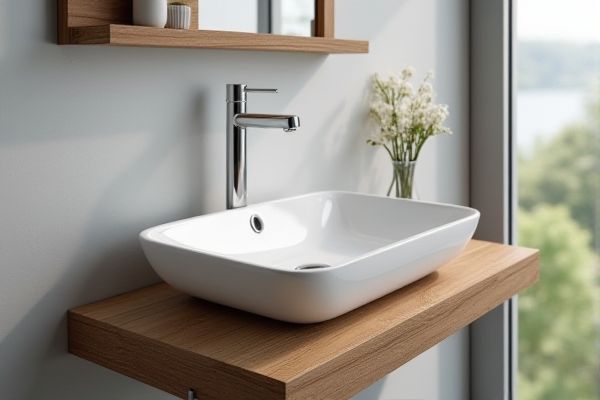
Top-mount sinks are installed by placing the basin over the countertop, offering easy installation and a classic look, while wall-mount sinks attach directly to the wall, saving floor space and providing a modern, minimalist aesthetic. Discover the key differences and which option best suits Your bathroom needs by reading the rest of this article.
Table of Comparison
| Feature | Top-Mount Sink | Wall-Mount Sink |
|---|---|---|
| Installation | Mounted on countertop with rim above surface | Directly fixed to wall, no countertop needed |
| Space Efficiency | Uses countertop space, requires cabinetry | Frees floor space, ideal for small bathrooms |
| Accessibility | Standard height, less accessible for wheelchair users | Height can be customized, wheelchair-friendly |
| Maintenance | Edge can trap dirt; moderate cleaning needed | Easy to clean underneath; fewer crevices |
| Support & Durability | Supported by countertop and cabinetry | Requires strong wall support and anchors |
| Style | Traditional look, versatile styles | Modern, minimalist design preferred |
| Cost | Generally lower installation cost | Higher installation cost due to wall reinforcement |
Introduction to Top-Mount and Wall-Mount Sinks
Top-mount sinks, also known as drop-in sinks, are installed by dropping the sink into a countertop cutout, creating a raised rim that sits on the counter surface. Wall-mount sinks, alternatively, are affixed directly to the wall without requiring countertop support, offering a streamlined, space-saving design ideal for small bathrooms. Each type provides distinct installation methods, aesthetic appeal, and functional benefits that influence bathroom layout and overall usability.
Design and Aesthetic Appeal
Top-mount sinks offer a classic design with an exposed rim that seamlessly integrates with various countertop materials, enhancing traditional and contemporary kitchens alike. Wall-mount sinks present a minimalist, floating appearance that maximizes floor space and creates an open, modern aesthetic ideal for small or industrial-style bathrooms. Both sink types provide distinct visual impacts, with top-mount sinks emphasizing countertop elegance and wall-mount sinks highlighting sleek, space-saving design.
Installation Complexity and Requirements
Top-mount sinks feature a rim that rests on the countertop, making installation simpler with straightforward cutout measurements and standard plumbing connections. Wall-mount sinks require secure wall studs and reinforced mounting brackets to support their weight, demanding more precise plumbing adjustments and stronger structural support. Your choice between these sink types should consider ease of installation and whether your space can accommodate the necessary wall reinforcement and plumbing modifications.
Space Efficiency and Usage
Top-mount sinks offer excellent space efficiency by fitting snugly into countertop cutouts, maximizing available counter space and providing a seamless integration with cabinetry. Wall-mount sinks free up floor space below, making them ideal for small bathrooms or utility areas where accessibility and open under-sink storage are priorities. Both options optimize usage differently: top-mount sinks enhance countertop usability, while wall-mount sinks increase room for plumbing access and wheelchair accessibility.
Cost Comparison
Top-mount sinks typically cost less than wall-mount sinks due to simpler installation and lower labor expenses. Wall-mount sinks require reinforced wall support and more complex plumbing, which increases overall costs. Your choice affects budget efficiency, with top-mount sinks offering a more budget-friendly option for standard bathroom and kitchen upgrades.
Maintenance and Cleaning
Top-mount sinks offer easier access for routine maintenance since their rims sit above the countertop, preventing water from seeping underneath and reducing grime buildup. Wall-mount sinks free up floor space and simplify cleaning beneath the basin but may require more careful upkeep to prevent leaks along the mounting points. Choosing your sink type depends on the level of cleaning convenience and maintenance effort you prefer for your bathroom or kitchen.
Durability and Longevity
Top-mount sinks, securely installed on a countertop, typically offer enhanced durability due to their robust support and resistance to heavy usage. Wall-mount sinks, while saving floor space, may experience more wear over time at the mounting points, potentially affecting their longevity if not properly installed or maintained. Choosing the right sink depends on your bathroom's usage intensity and structural support to ensure lasting performance.
Accessibility Features
Top-mount sinks feature easier installation and standard counter compatibility but may pose challenges for wheelchair users due to fixed countertop height. Wall-mount sinks provide enhanced accessibility by allowing adjustable height settings and clear knee space underneath, ideal for accommodating wheelchair users and individuals with limited mobility. Choosing wall-mount designs improves maneuverability and promotes compliant ADA-accessible bathroom or kitchen installations.
Best Applications and Room Suitability
Top-mount sinks are ideal for kitchens and bathrooms where countertop space integration and easy installation are priorities, offering compatibility with various countertop materials. Wall-mount sinks suit small bathrooms or powder rooms with limited floor space, providing a minimalist look and freeing up area beneath for storage or accessibility. Your choice depends on room size and functional needs, with top-mount sinks excelling in countertop-heavy rooms and wall-mount sinks perfect for compact or accessible environments.
Conclusion: Which Sink is Right for You?
Choosing between a top-mount sink and a wall-mount sink depends on your kitchen layout and functional needs. Top-mount sinks offer easy installation and countertop support, making them ideal for traditional kitchens, while wall-mount sinks save space and provide a modern, minimalist look perfect for small or contemporary settings. Your decision should balance aesthetics, available space, and ease of maintenance to find the sink that best fits your lifestyle.
 homyna.com
homyna.com